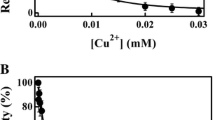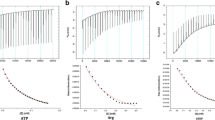Abstract
Arginine kinase (AK) is a key metabolic enzyme for maintaining energy balance in invertebrates and studies on AK from Euphausia superba might provide important insights into the metabolic enzymes in extreme climatic marine environments. A folding study of the AK from E. superba (ESAK) has not yet been reported. To gain insights into the structural and folding mechanisms of ESAK, the denaturants guanidine HCl and urea were applied in this study. We purified ESAK from the muscle of E. superba and evaluated the inhibition kinetics with structural unfolding studies under various conditions. The results revealed that ESAK was almost completely inactivated when using 1.0 M guanidine HCl and 8.25 M urea. The kinetics, characterized via time-interval measurements, showed that the inactivations by guanidine HCl and urea were first-order reactions, with the kinetic processes shifting from monophases to biphases as concentrations increased. Measurements of intrinsic and ANS (anilinonaphthalene-8-sulfonate)-binding fluorescences showed that guanidine HCl and urea induced conspicuous changes in tertiary structures and followed the regular unfolding mechanisms. Our study provides information regarding the folding of this muscle-derived metabolic enzyme and expands our knowledge and understanding of invertebrate metabolisms.









Similar content being viewed by others
Abbreviations
- ESAK:
-
Arginine kinase from Euphausia superba
- ANS:
-
1-Anilinonaphthalene-8-sulfonate
References
Mohan, P. M., & Hosur, R. V. (2009). Structure–function–folding relationships and native energy landscape of dynein light chain protein: nuclear magnetic resonance insights. Journal of Biosciences, 34, 465–479.
Teixeira, J. (2009). Dynamics of hydration water in proteins. General Physiology and Biophysics, 28, 168–173.
Speed, S. R., Baldwin, J., Wong, R. J., & Wells, R. M. (2001). Metabolic characteristics of muscles in the spiny lobster, Jasus edwardsii, and responses to emersion during simulated live transport. Comparative Biochemistry and Physiology. Part B, Biochemistry & Molecular Biology, 28, 435–444.
Holt, S. M., & Kinsey, S. T. (2002). Osmotic effects on arginine kinase function in living muscle of the blue crab Callinectes sapidus. Journal of Experimental Biology, 205, 1775–1785.
Muhelebach, S. M., Gross, M., Wirz, T., Wallimann, T., Perriard, J. C., & Wyss, M. (1994). Sequence homology and structure predictions of the creatine kinase isoenzymes. Molecular and Cellular Biochemistry, 133(134), 245–262.
Suzuki, T., & Furukohri, T. (1994). Evolution of phosphagen kinase: primary structure of glycocyamine kinase and arginine kinase from invertebrates. Journal of Molecular Biology, 237, 353–357.
Held, B. C., Wright-Weber, B., & Grossman, S. H. (2007). Kinetic analysis of two purified forms of arginine kinase: absence of cooperativity in substrate binding of dimeric phosphagen kinase. Comparative Biochemistry and Physiology Part B: Biochemistry and Molecular Biology, 148, 6–13.
Umair, S., Knight, J. S., Bland, R. J., & Simpson, H. V. (2013). Molecular and biochemical characterisation of arginine kinases in Haemonchus contortus and Teladorsagia circumcincta. Experimental Parasitology, 134, 362–367.
Suzuki, T., Kawasaki, Y., Unemi, Y., Nishimura, Y., Soga, T., Kamidochi, M., et al. (1998). Gene duplication and fusion have occurred frequently in the evolution of phosphagen kinase — a two domain arginine kinase from the clam Pseudocardium sachalinensis. Biochimica et Biophysica Acta, 1388, 253–259.
Zhou, G., Somasundaram, T., Blanc, E., Parthasarathy, G., Ellington, W. R., & Chapman, M. S. (1998). Transition state structure of arginine kinase: implications for catalysis of bimolecular reactions. Proceedings of the National Academy of Sciences of the United States of America, 95, 8449–8454.
Liu, N., Wang, J. S., Wang, W. D., & Pan, J. C. (2011). The role of Cys271 in conformational changes of arginine kinase. International Journal of Biological Macromolecules, 49, 98–102.
Pan, J. C., Yu, Z., Su, X. Y., Sun, Y. Q., Rao, X. M., & Zhou, H. M. (2004). Unassisted refolding of urea-denatured arginine kinase from shrimp Feneropenaeus chinensis: evidence for two equilibrium intermediates in the refolding pathway. Protein Science, 13, 1892–1901.
Yu, Z., Pan, J., & Zhou, H. M. (2002). A direct continuous pH-spectrophotometric assay for arginine kinase activity. Protein and Peptide Letters, 9, 545–552.
Tams, J. W., & Welinder, K. G. (1996). Unfolding and refolding of Coprinus cinereus peroxidase at high pH, in urea, and at high temperature. Effect of organic and ionic additives on these processes. Biochemistry, 35, 7573–7579.
Kamoun, P. P. (1988). Denaturation of globular proteins by urea: breakdown of hydrogen or hydrophobic bonds? Trends in Biochemical Sciences, 13, 424–425.
Hagihara, Y., Tan, Y., & Goto, Y. (1994). Comparison of the conformational stability of the molten globule and native states of horse cytochrome c. Effects of acetylation, heat, urea and guanidine-hydrochloride. Journal of Molecular Biology, 237, 336–348.
Pace, C. N. (1986). Determination and analysis of urea and guanidine hydrochloride denaturation curves. Methods in Enzymology, 131, 266–280.
Wang, G. F., Cao, Z. F., Zhou, H. M., & Zhao, Y. F. (2000). Comparison of inactivation and unfolding of methanol dehydrogenase during denaturation in guanidine hydrochloride and urea. The International Journal of Biochemistry & Cell Biology, 32, 873–878.
Gross, M., Lustig, A., Wallimann, T., & Furter, R. (1995). Multiple-state equilibrium unfolding of guanidino kinases. Biochemistry, 34, 10350–10357.
Tsou, C. L. (1993). Conformational flexibility of enzyme active sites. Science, 262, 380–381.
Acknowledgments
This study was supported by the Ningbo international cooperation project (No. 2012D10012). Dr. Guo-Ying Qian was supported by the National Natural Science Foundation of China (No. 31272638) and the Innovation Team Project of Ningbo Municipal Science and Technology Bureau (No. 2012B82016). Dr. Shang-Jun Yin was supported by a grant from the 624 project supported by the Zhejiang Leading Team of Science and Technology Innovation (Team No. 2010R50019). Dr. Jun-Mo Yang was supported by a grant of the Korea Health Technology R&D Project, Ministry of Health & Welfare, Republic of Korea (No. HI12C1299) and by a grant from the Samsung Biomedical Research Institute (GL1-B2-181-1). Dr. Yong-Doo Park was supported by a fund from the Science and Technology Planning Project of Jiaxing (No. 2012AY1041).
Author information
Authors and Affiliations
Corresponding authors
Additional information
Y.-X. Si and N.-Y. Fang contributed equally to this study.
Rights and permissions
About this article
Cite this article
Si, YX., Fang, NY., Wang, W. et al. Folding Studies of Arginine Kinase from Euphausia superba Using Denaturants. Appl Biochem Biotechnol 172, 3888–3901 (2014). https://doi.org/10.1007/s12010-014-0802-9
Received:
Accepted:
Published:
Issue Date:
DOI: https://doi.org/10.1007/s12010-014-0802-9




